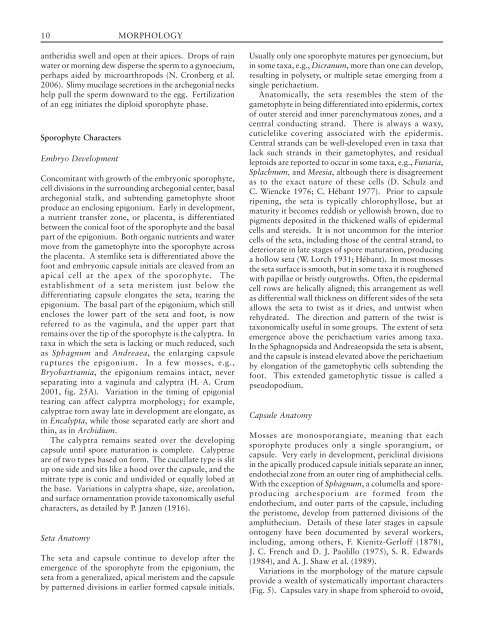Morphology of Mosses (Phylum Bryophyta)
Morphology of Mosses (Phylum Bryophyta)
Morphology of Mosses (Phylum Bryophyta)
You also want an ePaper? Increase the reach of your titles
YUMPU automatically turns print PDFs into web optimized ePapers that Google loves.
10 MORPHOLOGY<br />
antheridia swell and open at their apices. Drops <strong>of</strong> rain<br />
water or morning dew disperse the sperm to a gynoecium,<br />
perhaps aided by microarthropods (N. Cronberg et al.<br />
2006). Slimy mucilage secretions in the archegonial necks<br />
help pull the sperm downward to the egg. Fertilization<br />
<strong>of</strong> an egg initiates the diploid sporophyte phase.<br />
Sporophyte Characters<br />
Embryo Development<br />
Concomitant with growth <strong>of</strong> the embryonic sporophyte,<br />
cell divisions in the surrounding archegonial center, basal<br />
archegonial stalk, and subtending gametophyte shoot<br />
produce an enclosing epigonium. Early in development,<br />
a nutrient transfer zone, or placenta, is differentiated<br />
between the conical foot <strong>of</strong> the sporophyte and the basal<br />
part <strong>of</strong> the epigonium. Both organic nutrients and water<br />
move from the gametophyte into the sporophyte across<br />
the placenta. A stemlike seta is differentiated above the<br />
foot and embryonic capsule initials are cleaved from an<br />
apical cell at the apex <strong>of</strong> the sporophyte. The<br />
establishment <strong>of</strong> a seta meristem just below the<br />
differentiating capsule elongates the seta, tearing the<br />
epigonium. The basal part <strong>of</strong> the epigonium, which still<br />
encloses the lower part <strong>of</strong> the seta and foot, is now<br />
referred to as the vaginula, and the upper part that<br />
remains over the tip <strong>of</strong> the sporophyte is the calyptra. In<br />
taxa in which the seta is lacking or much reduced, such<br />
as Sphagnum and Andreaea, the enlarging capsule<br />
ruptures the epigonium. In a few mosses, e.g.,<br />
Bryobartramia, the epigonium remains intact, never<br />
separating into a vaginula and calyptra (H. A. Crum<br />
2001, fig. 25A). Variation in the timing <strong>of</strong> epigonial<br />
tearing can affect calyptra morphology; for example,<br />
calyptrae torn away late in development are elongate, as<br />
in Encalypta, while those separated early are short and<br />
thin, as in Archidium.<br />
The calyptra remains seated over the developing<br />
capsule until spore maturation is complete. Calyptrae<br />
are <strong>of</strong> two types based on form. The cucullate type is slit<br />
up one side and sits like a hood over the capsule, and the<br />
mitrate type is conic and undivided or equally lobed at<br />
the base. Variations in calyptra shape, size, areolation,<br />
and surface ornamentation provide taxonomically useful<br />
characters, as detailed by P. Janzen (1916).<br />
Seta Anatomy<br />
The seta and capsule continue to develop after the<br />
emergence <strong>of</strong> the sporophyte from the epigonium, the<br />
seta from a generalized, apical meristem and the capsule<br />
by patterned divisions in earlier formed capsule initials.<br />
Usually only one sporophyte matures per gynoecium, but<br />
in some taxa, e.g., Dicranum, more than one can develop,<br />
resulting in polysety, or multiple setae emerging from a<br />
single perichaetium.<br />
Anatomically, the seta resembles the stem <strong>of</strong> the<br />
gametophyte in being differentiated into epidermis, cortex<br />
<strong>of</strong> outer stereid and inner parenchymatous zones, and a<br />
central conducting strand. There is always a waxy,<br />
cuticlelike covering associated with the epidermis.<br />
Central strands can be well-developed even in taxa that<br />
lack such strands in their gametophytes, and residual<br />
leptoids are reported to occur in some taxa, e.g., Funaria,<br />
Splachnum, and Meesia, although there is disagreement<br />
as to the exact nature <strong>of</strong> these cells (D. Schulz and<br />
C. Wiencke 1976; C. Hébant 1977). Prior to capsule<br />
ripening, the seta is typically chlorophyllose, but at<br />
maturity it becomes reddish or yellowish brown, due to<br />
pigments deposited in the thickened walls <strong>of</strong> epidermal<br />
cells and stereids. It is not uncommon for the interior<br />
cells <strong>of</strong> the seta, including those <strong>of</strong> the central strand, to<br />
deteriorate in late stages <strong>of</strong> spore maturation, producing<br />
a hollow seta (W. Lorch 1931; Hébant). In most mosses<br />
the seta surface is smooth, but in some taxa it is roughened<br />
with papillae or bristly outgrowths. Often, the epidermal<br />
cell rows are helically aligned; this arrangement as well<br />
as differential wall thickness on different sides <strong>of</strong> the seta<br />
allows the seta to twist as it dries, and untwist when<br />
rehydrated. The direction and pattern <strong>of</strong> the twist is<br />
taxonomically useful in some groups. The extent <strong>of</strong> seta<br />
emergence above the perichaetium varies among taxa.<br />
In the Sphagnopsida and Andreaeopsida the seta is absent,<br />
and the capsule is instead elevated above the perichaetium<br />
by elongation <strong>of</strong> the gametophytic cells subtending the<br />
foot. This extended gametophytic tissue is called a<br />
pseudopodium.<br />
Capsule Anatomy<br />
<strong>Mosses</strong> are monosporangiate, meaning that each<br />
sporophyte produces only a single sporangium, or<br />
capsule. Very early in development, periclinal divisions<br />
in the apically produced capsule initials separate an inner,<br />
endothecial zone from an outer ring <strong>of</strong> amphithecial cells.<br />
With the exception <strong>of</strong> Sphagnum, a columella and sporeproducing<br />
archesporium are formed from the<br />
endothecium, and outer parts <strong>of</strong> the capsule, including<br />
the peristome, develop from patterned divisions <strong>of</strong> the<br />
amphithecium. Details <strong>of</strong> these later stages in capsule<br />
ontogeny have been documented by several workers,<br />
including, among others, F. Kienitz-Gerl<strong>of</strong>f (1878),<br />
J. C. French and D. J. Paolillo (1975), S. R. Edwards<br />
(1984), and A. J. Shaw et al. (1989).<br />
Variations in the morphology <strong>of</strong> the mature capsule<br />
provide a wealth <strong>of</strong> systematically important characters<br />
(Fig. 5). Capsules vary in shape from spheroid to ovoid,
















